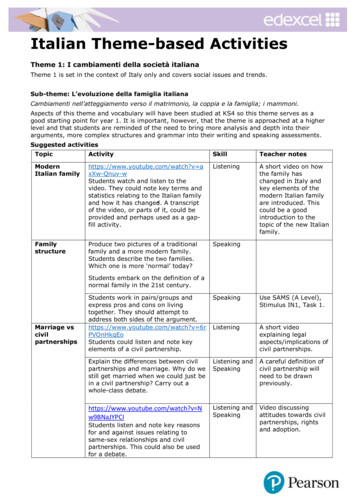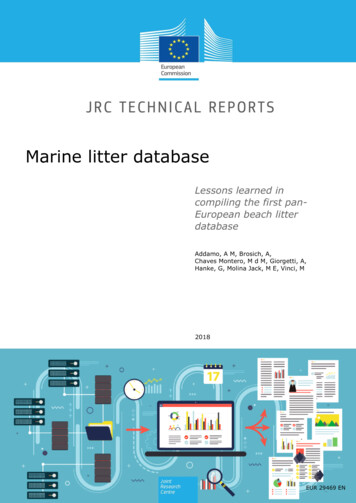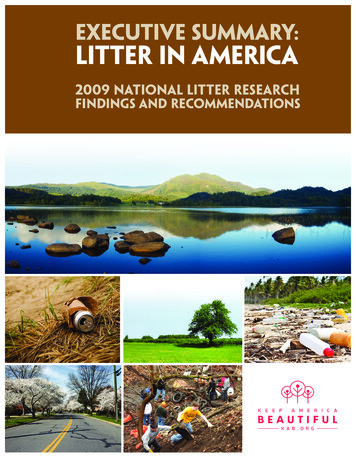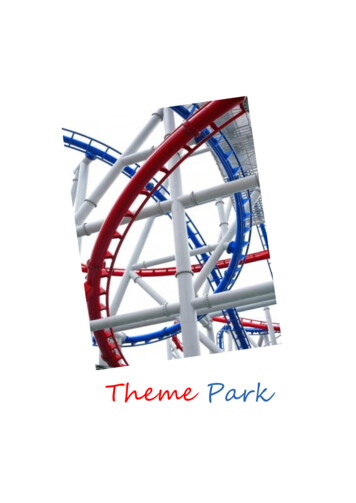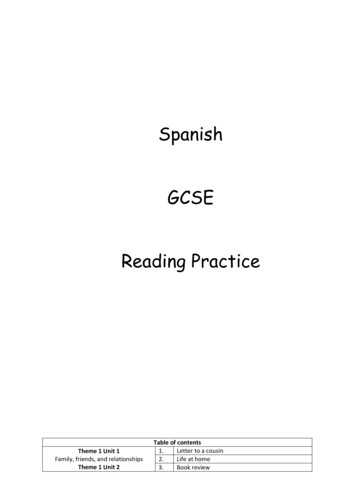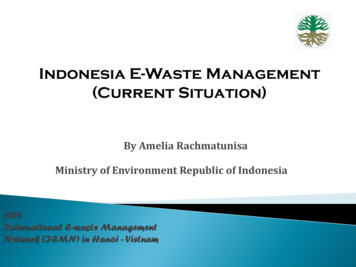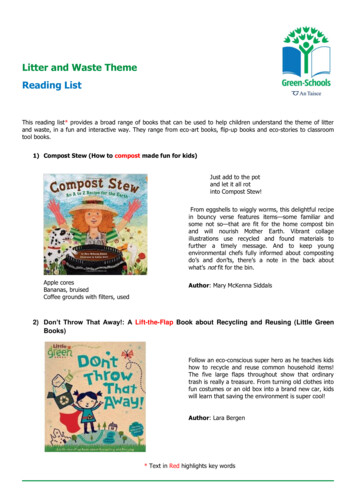
Transcription
Litter and Waste ThemeReading ListThis reading list* provides a broad range of books that can be used to help children understand the theme of litterand waste, in a fun and interactive way. They range from eco-art books, flip-up books and eco-stories to classroomtool books.1) Compost Stew (How to compost made fun for kids)Just add to the potand let it all rotinto Compost Stew!From eggshells to wiggly worms, this delightful recipein bouncy verse features items—some familiar andsome not so—that are fit for the home compost binand will nourish Mother Earth. Vibrant collageillustrations use recycled and found materials tofurther a timely message. And to keep youngenvironmental chefs fully informed about compostingdo’s and don’ts, there’s a note in the back aboutwhat’s not fit for the bin.Apple coresBananas, bruisedCoffee grounds with filters, usedAuthor: Mary McKenna Siddals2) Don’t Throw That Away!: A Lift-the-Flap Book about Recycling and Reusing (Little GreenBooks)Follow an eco-conscious super hero as he teaches kidshow to recycle and reuse common household items!The five large flaps throughout show that ordinarytrash is really a treasure. From turning old clothes intofun costumes or an old box into a brand new car, kidswill learn that saving the environment is super cool!Author: Lara Bergen* Text in Red highlights key words
Green-Schools ProgrammeReading List3) Earth-Friendly Crafts: Clever Ways to Reuse Everyday Items (Art)(For older children (5 ) but some good ideas that can be adapted for younger kids)What do you do with old toys, clothes, and otherstuff? Instead of throwing them away, get creativeand see what crafts you can make!This book shows you how to make crafts out of oldplaying cards, marker caps, toy cars, neckties,hairbrushes, and more. Colour photos of the finishedcrafts and step-by-step illustrations make these craftsa snap. Along with 21 crafts, you'll find informationabout recycling and tips for what you can do to helpthe planet. So find new uses for your old stuff and getcrafting!Author: Kathy Ross4) Eco Art!: Earth-Friendly Art and Craft Experiences for 3-to 9-year Olds (Art)This book is suitable for ages 3 to 9 years. The authorcombines her intuitive sense of each child's need forself-expression and interaction with nature with herwealth of imaginative experiences. All the projects userecyclable, reusable, household materials and/or itemsfound in nature.Author: Laurie Carlson5) Help The Environment, Cleaning Up Litter(Age Level: 4 and up Series: Help the Environment)This series introduces very young children to theconcept of caring for the environment in an attractiveand accessible way. Based on children's real-lifeexperiences, the books focus on things children can doto help the environment and keep the world around usclean. In this book, children learn what litter is, how itcan harm the environment, and what they can do tohelp clean up litter.2
Green-Schools ProgrammeReading List6) Help The Environment, Reusing and Recycling(Age Level: 4 and Up / Series: Help the Environment)This series introduces very young children to theconcept of caring for the environment in an attractiveand accessible way. Based on children's real-lifeexperiences, the books focus on things children can doto help the environment and keep the world around usclean. In this book, children learn about reusing andrecycling common household materials includingpaper, glass, plastic, and metal.7) How to Help the Earth by the Lorax(Catchy rhymes and great illustrations for kids 5 )The star of The Lorax by Dr. Seuss makes his Stepinto Reading debut in this rhymed reader that offerskids easy suggestions for going green! After explaininghow the trash in a wastebasket ultimately ends up in alandfill or incinerator, the Lorax suggests realistic wayschildren can reduce waste, such as by carrying a lunchbox, donating old clothes and toys, sharing magazineswith friends, recycling cans and bottles, and usingrechargeable batteries. He also explains how they cansave energy around the home by turning off lights,taking shorter showers, donning sweaters to staywarm, and much, much more. All in all, this is a greatintroduction to helping the Earth and helping kids stepinto reading!Author: Tish Rabe3
Green-Schools ProgrammeReading List8) Little Green Books, Easy to be Green(Art, activities, fun facts and earth saving tips)Everyone’s talking about the environment these days,especially kids. But what can kids do? A lot! This bookis filled with cool colouring pages, Earth-saving tips,fun facts, and easy activities kids can do to help theenvironment. It's just what kids need to be green allby themselves!This colouring and activity book will be printed on100% post-consumer waste recycled paper with soyink. The paper is FSC.Author: Ellie O’Ryan9) Little Green Books, I Can Save the EarthWith no TV to watch, computer to play on, videogames to play with, Max finds there is a whole bigworld outside that he can make a difference in theenvironment.Kids can follow Max the Little Green Monster's journeyto environmental awareness and learn tips on howthey can become little green monsters themselves. Akid-friendly glossary of terms is included in the back ofthe book.Meet Max the Little Monster. He is a cute,furry green monster who is an environmentalnightmare. Among other things, he leaves onall the lights, keeps his computer plugged in,blasts the TV, hoards his old toys and uses somuch toilet paper it clogs the toilet untilfinally, his excessive ways cause a poweroutage.This 8x8 paperback is perfect bound and will beprinted on 100% post-consumer waste recycled paperwith soy-ink. The paper is FSC certified.Part of the Little Green Book Series.Author: Alison Inches4
Green-Schools ProgrammeReading List10) Look Out for Litter (Cloverleaf Books: Planet Protectors)Earth has a litter problem. How can you help? JoinTrina to learn how little pieces of trash can becomebig problems. Find out safe ways to take care of litter.Do your part to be a planet protector!Discover how to reduce, reuse, recycle, and more withTyler and Trina in the Planet Protectors series, part ofthe Cloverleaf Books(tm) collection. These nonfictionpicture books feature kid-friendly text and illustrationsto make learning fun!Author: Lisa Bullard11) Michael Recycle (Recycling Super Hero)Just in time for Earth Day on April 22, Michael Recycletells the adventures of a young superhero whosepower allows him to teach people about recycling.After cleaning up a town, the people declare: "ToMichael Recycle! The green-caped crusader, oursuper-green hero, the planet's new saviour!"Author: Ellie Bethel12) Michael Recycle Meets Doug the Litter BugLitterbug Doug is lazy. He is wasteful. He is messy.But worst of all, he hatesrecycling! The clean and green town where he lives isin danger from his lazy ways, not to mention sufferingfrom the stench released by the mountains of garbagethat Doug leaves wherever he goes! So strong is itsstink that even the army of rats that follow Dougaround are rethinking their friendship with him. It's upto Michael Recycle, planet Earth's green-capedcrusader, to show dastardly Doug the error of hisways.before it's too late!Author: Ellie Bethel5
Green-Schools ProgrammeReading List13) Michael Recycle Saves Christmas (Fun themed reuse and recycling book)Santa is in trouble-the elves are running out ofmaterials to make toys If something doesn't changefast there won't be any toys for kids this Christmaseach kid will only get one grey sock instead (therearen't enough socks for a pair even!). Cue MichaelRecycle, our super green hero, who flies in with amessage for Santa: Reuse and Recycle! Whilst Michaelteaches the elves to make gifts out of everyday items(bouncing balls out of lots of elastic bands, Christmasdecorations from tin cans, bracelets out of paperclips,etc), Solar Lola is busy providing enough light andelectricity for the hive of activity that ensues!Author: Ellie Bethel14) Michael Recycle and the Tree Top Cops(Useful to show connection between trees and paper production)Even super-heroes need a vacation, so where betterthan one of the world's natural wonders, the greatRedwood Forest! But disaster has struck and theforest is under threat. can Michael Recycle and hisnew friends, the Tree Top Cops, save the day?Author: Ellie Patterson15) Paper (Reduce, Reuse, Recycle)Read 'Paper' to discover where paper comes from,how it is made and used, and how paper waste affectsthe environment. Learn how paper can be reused andrecycled, and how to reduce your own paper waste.Author: Alexandra Fix6
Green-Schools ProgrammeReading List16) Peppa Pig Recycling FunPeppa and her family. The family are woken up by the'bin men' banging and crashing around early in themorning. Peppa and George help Mummy Pig to tidyup the breakfast things and to sort the bottles andnewspapers into different boxes for recycling. Thefamily take the boxes to the recycling centre, wherethey learn that Miss Rabbit loves to recycle so muchthat she tries to recycle the family car!This book encourages young children to recycle usinga recognisable character.This is one of a collection of books (based on thepopular animated TV series) about a little pig called17) Plastic (Reduce, Reuse, Recycle)Read 'Plastic' to discover how plastic is made, how it isused, and how plastic waste affects the environment.Learn how plastic can be reused and recycled, andhow to reduce your own plastic waste.Author: Alexandra Fix18) Recycle!: A Handbook for Kids (The recycling process)Explains the process of recycling from start to finishand discusses what happens to paper, glass,aluminium cans, and plastic when they are recycledinto new products.Author: Gail Gibbons7
Green-Schools ProgrammeReading List19) Recycled Crafts Box (Art)(For older kids but some great ideas that can be adapted for younger children)about anything we think of as trash can betransformedinto an art project good enough to give as a gift or tokeep and treasure yourself. Master crafter Laura C.Martin shows kids how to make art out of the paper,plastic, metal, and cloth we usually consign to therecycling bin or the garbage can.Corrugated Castle, Fancy Foil Fish Mobile, Paper BeadBangles, Braided Rag Coasters, Old Shoe Flower Pots,Puppy Dog Sock Puppet, with a little imagination, justAlong the way, Martin offers sidebars on the history ofrubbish and profiles of artists whose medium is junk.She passes along important lessons about being agood steward of the Earth. But the lessons are lightand fun--never preachy.Author: Laura C. Martin20) Rubbish!: Reuse Your Refuse (30 Art projects)Want to know what goodies you can make with yourgarbage? This book shows you how to give everydayhousehold items a new life the hip craftster’s way.You’ll discover how to complete more than 30 creativeprojects using materials you already have at yourdisposal, while reducing trash and up-cycling yourpersonal style. From a credit card bracelet to a mapphoto frame, this fun guide shows you how to createtruly one-of-a-kind pieces—one earth-friendly projectat a time.Author: Kate Shoup21) The Adventures of an Aluminium Can (Written in diary format)manufacturing line, to the store shelf, to a display ona bookshelf, to a garbage can, and finally to arecycling plant where it emerges into its new life as abaseball bat!This 8x8 paperback storybook is told from the point ofview of an enthusiastic aluminium can. The diaryentries are fun and humorous, yet point out theecological significance behind each product and theresources used to make it.Peek into this diary of an aluminium can as it goes ona journey from inside a bauxite rock, to theAuthor: Alison Inches8
Green-Schools ProgrammeReading List22) The Adventures of a Plastic Bottle (Written in diary format)journey from the refinery plant, to the manufacturingline, to the store shelf, to a garbage can, and finally toa recycling plant where it emerges into it's newlife.as a fleece jacket!Learn about recycling from a new perspective! Peekinto this diary of a plastic bottle as it goes on aTold from the point of view of a free-spirited plasticbottle, kids can share in the daily experiences andinner thoughts of the bottle through his personaljournal. The diary entries will be fun and humorousyet point out the ecological significance behind eachproduct and the resources used to make it. Readerswill never look at a plastic bottle the same way again!Author: Alison Inches23) The EARTH Book (Tips on how children can “Go Green”)of easy, smart ideas on how we can all work togetherto make the Earth feel good - from planting a tree andusing both sides of the paper, to saving energy andreusing old things in new ways.With his signature blend of playfulness and sensitivity,Todd Parr explores the important, timely subject ofenvironmental protection and conservation in this ecofriendly picture book. Featuring a circular die-cut Earthon the cover, and printed entirely with recycledmaterials and nontoxic soy inks, this book includes lotsBest of all, the book includes an interior gatefold witha poster with tips/reminders on how kids can "gogreen" everyday. Equally whimsical and heartfelt, thissweet homage to our beautiful planet is sure to inspirereaders of all ages to do their part in keeping theEarth happy and healthy.Author: Todd Parr24) The Great Trash Bash (A recycling story)recycle items instead of throwing everything away. Anexcellent book to teach young children aboutrecycling.Review 1. Mayor Hippo is very proud of his beautifulcity but he knows something is wrong. After slippingon a banana peel, he realizes the problem is trash.Mayor Hippo calls a town meeting and suggests theanimals have a trash bash. The citizens of Beastoncome up with ideas of their own. They realize they canReview 2. The Great Trash Bash is an EXCELLENTbook. As a informal educator with a non-profitorganization, I needed a book that covers wastereduction and recycling in a fun and innovative way.This book not only teaches recycling but many otheraspects of the reduce, reuse, recycle, respect loop.Even if teaching about waste issues isn't your "thing"the story is sweet and the illustrations are endearing.Excellent Book.Author: Loreen Leedy9
Green-Schools ProgrammeReading List25) The Three R’s: Reuse, Reduce, Recycle (Activities for children and parents)Attractive colour illustrations and easy-to-follow textcombine to present factualinformation that younger boys and girls will readilyabsorb and understand. The Three R's: Reuse,Reduce, Recycle is one in a series of four entertainingWhat Do You Know About? books, for very youngchildren. It describes the ways in which kids and theirfamilies can avoid waste and be environmentallyconscious. Four pages presenting activities for childrenappear at the back of the book, followed by a twopage section for parents, with tips on explaining thesubject in more detail.Series: What Do You Know About? BooksAuthor: Nuria Roca26) The Wartville Wizard (Litter story)Wartville is being buried in trash! There are sodabottles under the flowers, juice cans by the mailbox,and newspapers along the road. Every day the pilesgrow higher and higher.Then one tidy old man realizes he has the power toget rid of all the trash forever. Wartville will finally becleaned up once and for all!Author: Don Madden27) Where Does the Garbage Go? (Waste management: description, charts, solutions)Follow that garbage truck!.to the landfill to see how trash keeps pilingup.to the incinerator to see how trash can beturned into energy . to the recycling centre tosee how a soda bottle can be turned into aflowerpot. Filled with graphs, charts, anddiagrams, Where Does the Garbage Go?explains how we deal with the problem of toomuch trash and provides ideas for easy ways tobe a part of the solution.Author: Paul Showers10
Green-Schools ProgrammeReading List28) Why Should I Recycle? (Answers children’s questions about recycling)new products? Mr. Jones is a teacher who sets a goodexample for kids by separating his trash for recycling.When he takes them on a class trip to a recyclingplant they learn the value of recycling. Part of everychild's development involves asking questions. Today,some of the most important questions kids ask arerelated to the natural environment. The enlighteningand entertaining four-book Why Should I? seriesdemonstrates the importance of protecting nature.Books present brief, entertaining stories that answerchildren's questions and feature amusing colourillustrations on every page. A note at the back of eachbook is for parents and teachers, suggesting ways touse these books most effectively.What if everybody threw away old bottles andnewspapers, littering the world with glass and plasticand tin cans that should be recycled and made intoAuthor: Jen Green29) Garbage and Recycling (Young Discovers: Environmental Facts and Experiments)Explaining the difference between biodegradable andnon-biodegradable garbage, this book shows howglass, metal, and wool can be easily recycled. HowCan I Help? Boxes give suggestions for the youngenvironmentalist who wants to recycle at home.Author: Rosie Harlow and Sally Morgan11
Michael Recycle! The green-caped crusader, our super-green hero, the planet's new saviour!" Author: Ellie Bethel 12)Michael Recycle Meets Doug the Litter Bug Litterbug Doug is lazy. He is wasteful. He is messy. But worst of all, he hates recycling! The clean and green town where he lives is in danger from his lazy ways, not to mention suffering


